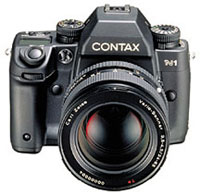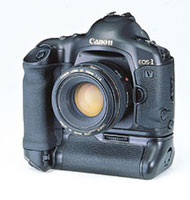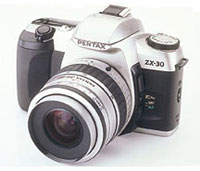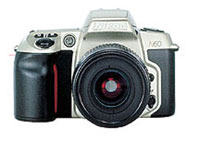SLR Cameras
Once every two years, the world's largest photographic trade show--photokina--is held in Cologne, Germany, in September. In those years (including 2000) we always find that camera manufacturers announce SLR models with entirely new technology. This year was no exception, with four major cameras announced just before photokina, some with technology that is both surprising and innovative. These late arrivals tend to steal the show and then get all of the publicity. However, 2000 was a great year overall, because even the SLR models introduced earlier were of significant interest to photographers of various levels. Autofocus Contax System. Although Contax already offered an autofocus SLR camera--the AX with unique back focusing system--the N1 is the first of their new AF system. Unlike the AX, the N1 is designed for use with a new line of Carl Zeiss T* autofocus lenses including Ultrasonic focus motor. Even in autofocus mode, the user can touch up focus manually, without the need to flip a switch. The five-point diagonal autofocus system also offers a unique feature. Fine focus bracketing shifts the focus point automatically over the subsequent frames so the point of focus differs slightly in each image. For manual selection of a focus sensor--or two adjacent sensors--a stubby "joystick" is provided on the camera back. Another first is the optional LCD Viewfinder FE-1 that attaches to the camera's eyepiece. Similar to the monitor of digital cameras, the FE-1 features a 1.5" square, 330,000 pixel CCD panel, useful for checking the appearance of the final photograph. In remote control operation, the FE-1 can be placed some distance from the camera, attached to the N1 with an electronic cable. This allows for remote photography without the need to view the scene through the camera's conventional viewfinder. Naturally, the Contax N1 is a full-featured model with Matrix, Center-Weighted and Spot metering; sophisticated flash metering control; 20 custom functions; shutter speed range from 1/8000 to 32 sec; the usual modes and overrides; eyepiece diopter adjustment; 3.5 fps motor drive; and more. The optional multifunction D-10 back allows for date and exposure data imprinting on the first two frames of film, or in the spaces between frames. A hefty camera with a professional look and feel, the Contax N1 also accepts the Carl Zeiss 645-series lenses using the optional adapter NAM-1. |
|
Professional EOS Model. The fifth professional 1-series SLR camera made by Canon, the EOS-1 V incorporates virtually every capability currently available. Most notable is the 10 fps film advance (9 fps in continuous AF) with the optional PB-E2 and Ni-MH battery pack. However, there's a lot more, like the 45 point autofocus sensor with several user-selected options and additional crosshatched sensors for greater reliability. In metering, upgrades include a 21 zone evaluative meter, multi-spot, and 21 zone E-TTL flash sensor. Standard flash synch is 1/250 sec, but with EX-series Speedlites, high-speed synch to 1/8000 sec can be selected. Flash exposure lock and bracketing, modeling light support, plus wireless remote E-TTL flash with adjustable ratio output round out the new flash capabilities. Other notable features include built-in memory for shooting data for 100 rolls, transferred to a PC via optional EOS Link, plus film roll ID number imprinting on Frame 0 with the standard back. The 20 Custom Functions--plus 31 Personal Functions with EOS Link--enable the camera to be custom tailored to every photographer's own preferences. Extensive use of magnesium alloy and sealing for weather-resistance assure maximum reliability while the new shutter has been tested for 150,000 cycles. The AF system's new algorithm uses more focusing data than previous models did, for incredibly fast continuous autofocus. The increased choice in the number of active AF points makes the camera highly versatile. The ability to shoot action subjects at 9 fps--with predictive autofocus--will be a real benefit for action photography. Finally, the flash capabilities of the EOS-1 V are light years ahead of those of the EOS-1N, in automation, convenience, and personal control. Working pros who need a camera that's extremely rugged and weatherproof--for use in any condition during an assignment--will definitely want the EOS-1 V. As a bonus, they'll find that it's also super fast, unusually versatile, fully controllable, highly reliable, and capable of achieving any effect the photographer intends. |
|
Mid-Priced Canon. As the third generation of the popular EOS Elan line, the new Elan 7 and Elan 7E includes most Elan II features while adding others in a redesigned body. These are identical cameras, with high-speed seven point CMOS autofocus system, but the Elan 7E includes Eye Controlled Focus--"the fastest ever." More importantly, this is the first Canon model with ECF that also offers eyepiece diopter correction, appreciated by those whose eyesight is less than perfect. As expected, the eye control system of the Elan 7E has been refined, for more precise operation in both horizontal and vertical shooting. In some respects, the Elan 7 series is similar to the EOS-3 because it employs technology developed for that Pro camera. Most notable are the 35 zone evaluative metering and the highly sophisticated E-TTL flash control with wireless off-camera flash, flash exposure lock, bracketing, and compensation option. The latter is available with EX-series flash units such as the new Speedlite 420EX that allow for high-speed flash synch (to 1/4000 sec) when desired. Compact and lightweight, the Elan 7 cameras feature a durable metallic top cover and simplified controls for ease of use even by first time SLR buyers. The Elan II models were fairly quiet, but the improved Whisper Drive system makes the 7-series the quietest EOS cameras. Other features include 11 shooting modes; 13 custom functions; pop-up multimode flash; 4 fps motor drive (3.5 fps in continuous AF); the usual overrides including autoexposure bracketing, remote control terminal, Center-Weighted and partial area metering; plus depth of field preview button. When first examining the new EOS Elan 7, Bob Shell offered the following assessment: "I found that it fit my hands perfectly and as an EOS user I took to it immediately since all controls are in familiar locations. The knobs which controls camera functions have been made taller and easier to grip, a definite improvement in my opinion, while the overall contours are smooth and rounded and conform to your hands." |
|
User-Friendly Pentax. Designed to entice the owners of point-and-shoot compact cameras, the new Pentax ZX-30 facilitates the transition to an SLR model. Surprisingly compact, this attractive black and silver camera with auto pop-up flash is a perfect starter model for SLR novices. The six subject-specific Programs make it a fully automatic camera with six segment multi-pattern metering, while the mode selector dial assures maximum simplicity while taking great snapshots. However, this is a camera that will "grow" as its owner's demands increase, with a full complement of other capabilities: semiautomatic and Manual modes; 2 fps film advance; exposure override and AE Lock; multiple exposure capability; continuous predictive autofocus; and more. The new SAFOX VI autofocus system even allows the photographer to shoot a few sharply focused frames after a subject moves away from the (central) focus detection sensor. An eyepiece diopter adjustment switch and automatic viewfinder brightness control offer maximum convenience. With an optional Auto Zoom flash unit, some of the fine Pentax FA lenses, and a few accessories, the ZX-30 becomes a serious camera. Because it also accepts K-mount lenses, with some limitations, the new model can be an ideal backup to a manual focus Pentax camera for those first making the switch to a high tech AF model. |
|
High Tech Maxxum. Resembling the pro Maxxum 9 at first glance--with large knobs and dials--the Maxxum 7 is a futuristic camera with some unique new features. Most notable is the large dot-matrix LCD panel on the camera back offering a vast range of information at a glance, aiding the photographer with the camera's new "navigation system." By scrolling through the menu, the user can even access data on settings used for previous frames, as well as simple explanations of all custom functions in plain language. The autofocus system is highly advanced, with nine point sensor and quicker switching between AF and MF with a thumb-operated button. Another new feature: even when autofocus is locked, focus can be manually fine-tuned. A round rocker switch on the camera back allows for quick and easy selection of the desired sensor. The central point features a unique cross-hair sensor for highly reliable focus acquisition. AF operation is maintained even with f/6.7 lenses. This is the fastest continuous/predictive system of any Maxxum camera, great for high-speed action photography; Minolta indicates that accuracy "has almost doubled when compared to conventional camera models." The new flash metering system offers Advanced Distance Integration for difficult lighting conditions, with pre-flash metering. This feature requires the new D-type AF lenses--with built-in distance encoder--and the built-in flash or the new HSD series of accessory Program flash units. (With D-lenses, the focus ring does not rotate in AF operation with the Maxxum 7, thanks to an in-camera clutch.) Other amenities include flash exposure compensation, wireless off-camera TTL flash--now at synch speeds up to 1/8000 sec--and a PC cord socket. The list of other specifications is very long, and includes three metering patterns; 4 fps film advance (3.7 fps in Continuous AF); AE Lock, even in Manual mode, allowing for various aperture/shutter speed combinations at the same exposure value; versatile AEB system; multiple exposure; data memory for up to seven rolls of film (retrieved with an accessory); eye-start automation; 34 custom functions; eyepiece diopter adjustment; reflex mirror lockup; depth of field preview; and more. The Maxxum 7 incorporates some other unique features not easily explained in a few words. These include depth of field display, brightness distribution display, automatic advance to a specific film frame, film chamber safety lock, and soft focus mode. These will be covered in detail in a forthcoming test report. By far the most technically advanced Minolta camera ever, the Maxxum 7 can be as simple to operate as desired, but also holds a great deal more potential. This does require some study of the Owners Manual and subsequent practice, but the extra effort certainly pays dividends in terms of photographic problem solving. |
|
Nikon Semi-Pro. Responding to a demand for an affordable SLR camera with the best capabilities of the F100, Nikon introduced a hybrid metal/polycarbonate body that is far more compact. Available at an attractive price, the Nikon N80 incorporates similar technology in exposure control, flash metering, and autofocus. Like the F100, the new model offers Dynamic autofocus with selectable Closest Subject Priority, overlap servo and Focus Tracking with Lock-On for effective action photography, selectable single Area AF, and five sensor cross array. Intended for use with AF lenses, the N80 incorporates numerous high tech capabilities. Grid lines appear on the viewing screen on demand. A comprehensive light metering system includes spot and 10 zone Matrix metering, AEB, Multi-Sensor Balanced fill flash, and flash exposure compensation. Other features include the usual operating modes and overrides, depth of field preview, multiple exposure, 18 custom functions, eyepiece diopter correction, 2.5 fps film advance, and a great deal more. Its flash metering capabilities especially are highly impressive. Nikon keeps making their SLR cameras better and better, upgrading technology, adding new capabilities, and improving ease of operation. Though not inexpensive like the N65, the N80 offers exceptional value for the price because of its many F100 features. Targeting photographers who want high tech capabilities that are 100 percent compatible with AF lenses, the superb performance of the new Nikon N80 will surely meet or exceed their demands. |
|
New Affordable Nikon. A well-specified entry-level model, the Nikon N60 was a popular camera but the new N65 offers more advanced capabilities. Maintaining the simplicity of operation, the N65 features large, conveniently located controls, including oversized mode and command dials. Five subject-specific programs allow for point-and-shoot operation, but all the overrides are available, too: semiautomatic and Manual mode, Center-Weighted metering, exposure compensation and now, AEB, multiple exposure, depth of field preview, and a fast 2.5 fps film advance. The viewfinder image is also noticeably brighter, an advantage especially in low-light situations. Most owners will use the advanced six-segment 3D Matrix Light Meter or Matrix Balanced fill flash with the built-in unit that pops up automatically when needed. Flash modes include Slow and Rear Curtain Synch, Redeye Reduction and Redeye Reduction with Slow Synch. Both smaller and lighter than the N60, the N65 is designed with a sleek, streamlined silver and black body that features a metal lens mount. In his preliminary review, Bob Shell offered the following comments about this significantly upgraded camera: "In my hands the Nikon N65 had a good, solid feel and the autofocus was very swift in finding focus. I really liked the N60 and can only say that this new camera seems to retain everything I liked about that camera and has added some important innovations." Manufacturers/Distributors |
- Log in or register to post comments








































